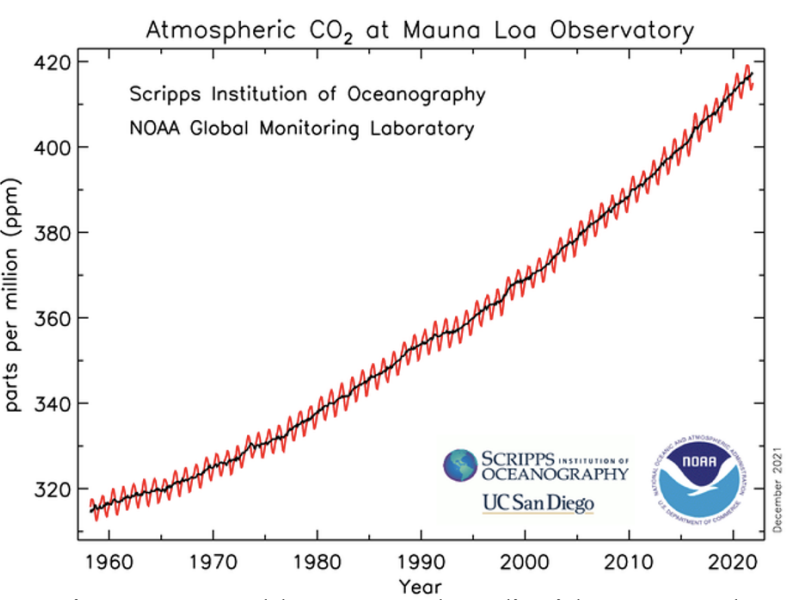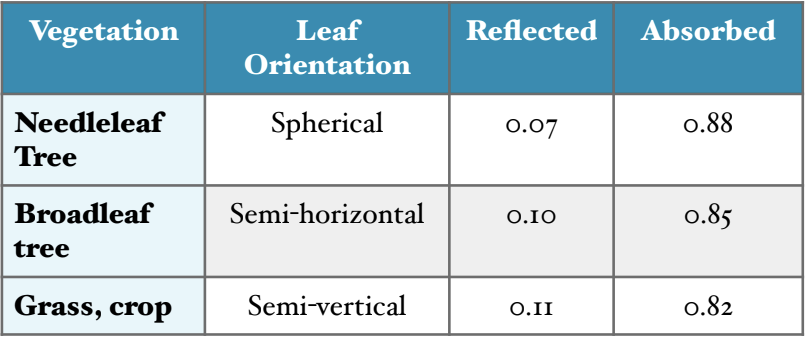How Do Plants Affect the Climate?
Washington – or at least, those parts of it not situated in rain shadows – is known for its greenery hence the nickname of the “Evergreen State”. The pervasive rain and mild temperatures allow plants to thrive during the rainy season. Have you ever stopped to ask, though, not what the climate does for plants, but what plants do for the climate?
On a global scale, plants have a big impact on the carbon cycle by way of photosynthesis. As you likely learned in grade school, with sunlight, water, and carbon dioxide, plants create oxygen and food for themselves. This process allows plants to be a significant sink for anthropogenic carbon emissions. Figure 1 shows data from the longest record of direct atmospheric CO2 measurements in the world, taken at the Mauna Loa Observatory in Hawaii. The thick black line shows average monthly CO2 measurements corrected for the seasonal cycle; the red line shows the same, but without the correction. The red line moves up and down as plants in the northern hemisphere blossom and wilt with the seasons. The net effect of plants is to remove CO2 from the atmosphere and store it safely away in soils and plant tissues, where it does not act to heat up the Earth. In fact, about 25% of all fossil fuel emissions from humans have been taken up by plants and soils.

Plants can have a big impact on local climates, too. In the rainier regions of the Pacific Northwest, plants have plenty of water and warm enough temperatures to survive, so they are mostly limited by sunlight in the amount they can grow. This has an impact on the characteristics of the plants that grow here. Take the three most common trees in the Pacific Northwest as examples: The Douglass Fir, the Western Red Cedar, and the Western Hemlock. All of these trees are needleleaf trees. According to a study by Dorman and Sellers (1989), needleleaf trees reflect less and absorb more sunlight than broadleaf trees, grasses, and crops (Table 1). Thus, the widespread growth of dark, needleleaf trees in Western Washington allows for more sunlight to be absorbed on average, which helps to increase the surrounding temperature. In contrast, the sunnier areas of Eastern Washington are more sparsely vegetated. With fewer forests and vast swaths of farmlands, prairies, and even deserts, more sunlight is reflected. This helps to keep Eastern Washington cooler than it would otherwise be.

Changing surface reflectivity is not the only way that plants impact local temperatures. Plants may heat up an area by absorbing more sunlight, but they can also cool down an area by something called transpiration. When a plant photosynthesizes, it opens valves on leaves (called stomata) to take in the surrounding air. This allows the plant to acquire the carbon dioxide necessary for photosynthesis, but in doing so, the plant loses some of its internal water stores to the air. This evaporation of water through foliage is called transpiration. Transpiration helps to cool the local climate down for the same reason that sweating cools humans down. Energy is required to change liquid water from a plant (or on your skin) into water vapor. If incoming solar energy is being used to complete this phase change, it cannot also be used to heat up the surrounding air. Plants draw up water from the soil that would otherwise not be available to moderate the surrounding climate, so in this way, plants can help to keep the local area cooler than it would otherwise be without plants.
So, which is it? Do plants absorb enough extra sunlight to have a net heating effect on a local area, or do they transpire enough to have a net cooling effect? According to Dr. Abigail Swann, Associate Professor of both Atmospheric Science and Biology at the University of Washington, the answer depends on the specifics of the locale in question. At higher latitudes in the Arctic, plants are much darker than the surrounding bright and snowy landscapes, so their impact on reflectivity is much more pronounced. There, plants may help to warm the environment. In the tropics, plants do a lot more photosynthesizing, allowing for more transpiration that cools the surrounding area.
In the mid-latitudes, and specifically the Pacific Northwest, these two effects are harder to disentangle from one another to determine a net effect. Additionally, given the very different climates and vegetation patterns of Eastern and Western Washington, the net impact of plants is likely very different on either side of the Cascades. Some studies and experiments have been done in the Pacific Northwest describing the climatological impacts of plants on the area, but the OWSC could find no synthesis of the existing literature. While creating such a synthesis is beyond the scope of this article, there is at least one impact of plants in Washington State we can be more certain of. Evidence suggests that a lack of plants is at least part of the reason that our largest population centers experience an “urban heat island effect.” Studies show that densely populated, urban areas are, on average, warmer than the surrounding outlying areas. The recent results of a heat mapping project conducted by King County and the City of Seattle show that areas with more vegetation and natural landscaping experience a smaller urban heat island effect than those without. These results are supported by other studies that show that vegetation can reduce the urban heat island effect.
We at the OWSC are grateful for everything plants do to keep our world and our cities more comfortable. We also give thanks to Dr. Swann and her graduate students, Greta Shum and Claire Zarakas, for their assistance with this article.
References:
Bonan, G., 2015: Ecological Climatology. Cambridge University Press, 692 pp.
Dorman, J.L and Sellers, P.J., 1989: A Global Climatology of Albedo, Roughness Length and Stomatal Resistance for Atmospheric General Circulation Models as Represented by the Simple Biosphere Model (SiB). J. Appl. M eteor. Climatol., 28, 833-855.